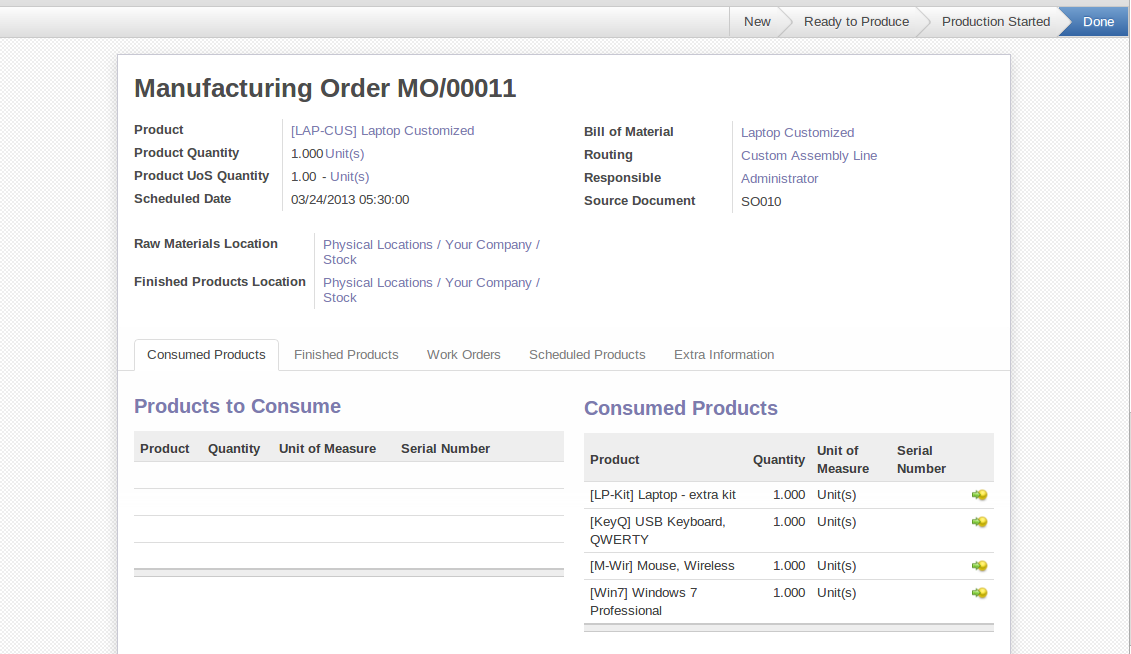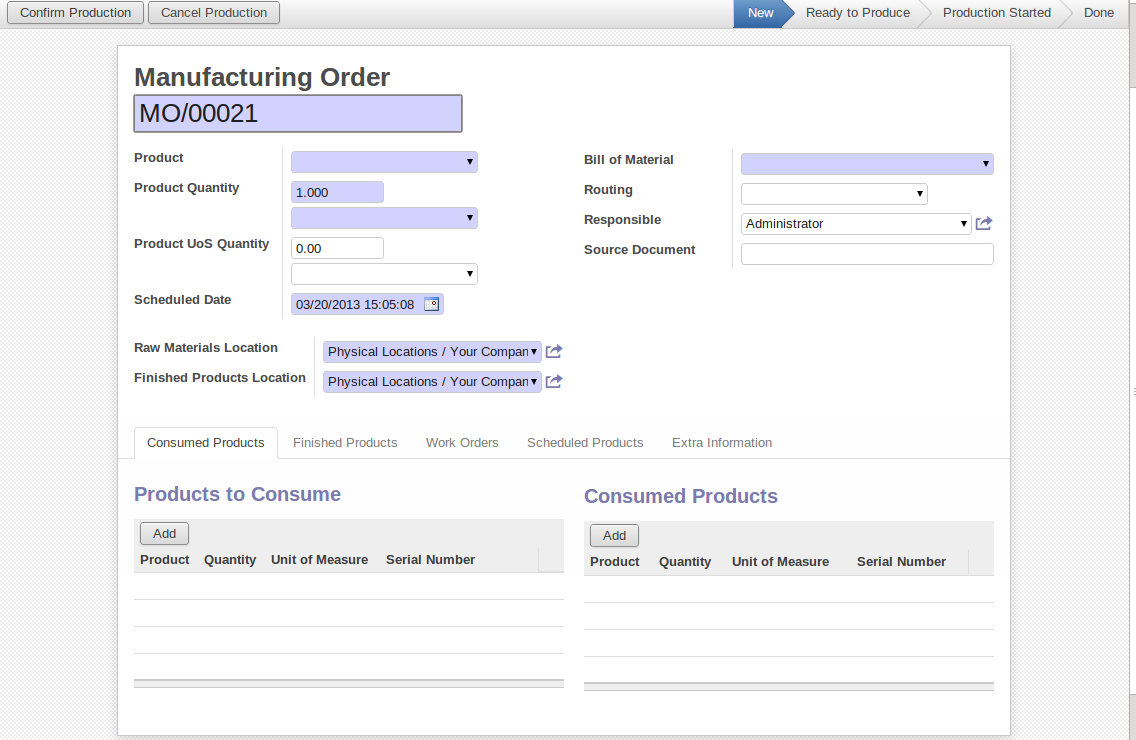Manufacturing Orders
Once the bills of materials have been defined, Odoo ERPOnline is capable of automatically deciding on the manufacturing route according to the needs of the company.
Production orders can be proposed automatically by the system depending on several criteria described in the preceding chapter:
- Using the
Make to Orderroute, - Using the
Order Point (Minimum Stock)rules, - Using the
Productionplan.
Of course, you can also start production manually by clicking the button Create in the menu Manufacturing > Manufacturing > Manufacturing Orders.

Manufacturing Order
If you have not installed the Just-in-Time planning module mrp_jit, you should start using Odoo ERPOnline to schedule the Production Orders automatically using the various system rules. To do this, use the menu Warehouse > Schedulers > Run Schedulers.
Complete Production Workflow
To understand the usefulness and the functioning of the system you should test a complete workflow on the ERPOnline demo. We will show you:
- How to create a sales order,
- The manufacturing workflow for an intermediate product,
- The manufacturing of an ordered product,
- The delivery of products to a customer,
- Invoicing at the end of the month,
- Traceability for after-sales service.
This more advanced case of handling problems in procurement will be sorted out later in the chapter.
The Sales Order
Begin by encoding a sales (or customer) order through the menu Sales > Sales > Quotation -> Create. Enter the following information:
Customer: Agrolait,Create Invoice: On Delivery Order (Other Information tab),Sales Order Lines, click Add an item:Product: [LAP-CUS] Laptop Customised,Quantity (UoM): 1,Product UoM: Unit(s),Procurement Method: on order.
Once the quotation has been entered, you can confirm it immediately by clicking the button Confirm Sale at the top. Keep note of the order reference because this follows all through the process. For example, this will be SO009. At this stage SO010

Process for Handling Sales Order SO010
Producing an Intermediate Product
To understand the implications of requirements calculation, you should know the configuration of the sold product. To do this, go to the form for product LAP-CUS and click the Product BoM Structure from the more button. You get the screen shown in Composition of LAP-CUS which is the composition of the selected product.

Composition of LAP-CUS
The LAP-CUS Customised Laptop has to be manufactured in two steps:
- The intermediate product: LP-Kit.
- The finished product using that intermediate product: LAP-CUS.
The manufacturing supervisor can then consult the production orders using the menu Manufacturing > Manufacturing > Manufacturing Orders. You then get a list of orders.

List of Manufacturing Orders
You will see the Manufacturing order for LP-Kit and one for [LAP-CUS] Laptop Customized because it depends on an intermediate product. Return to the Manufacturing order for LP-Kit and click it. If there are several of them, select the one corresponding to your order using the source document that contains your order number (in this example SO010).

Details of a Production Order
The system shows you that you have to manufacture product LAP-CUS using the components: LP-Kit. You can then confirm the production twice:
- Start production: consumption of raw materials.
- Produce: manufacturing of finished product.
Manufacturing order is Waiting for raw material, you should set the availability by clicking Force Reservation button.
Click the Mark as Started button, then click the Edit button, and edit the line for the product [DC]Datacard. Enter a serial number for it by putting the cursor in the field Serial Number and to create a new Number. Enter an internal reference, for example: MB1345678. The system may then show you a warning because this lot is not in stock, but you can ignore this message.
Click the Produce button to manufacture the finished product.
The production order has to be in the closed state as shown in the figure Production Order after the Different Stages.

Production Order after the Different Stages
Finished Product Manufacturing
Having manufactured the intermediate product LP-Kit, Odoo ERPOnline automatically proposes the manufacturing of the computer LAP-CUS using the order created earlier. Return to the Manufacturing Orders menu and look at the orders Ready to Produce through Manufacturing > Manufacturing > Manufacturing Orders.
You will find LAP-CUS which has been sold to the customer (source document SO010), as shown in the figure hereafter.

Completed Production for LAP-CUS
Now that the production has been completed, the product sold to the customer has been manufactured and the raw materials have been consumed and taken out of stock.
As well as managing the use of materials and the production of stocks, manufacturing can have the following automatic effects which are detailed further on in the chapter:
- adding value to stock,
- generating operations for assembly staff,
- automatically creating analytical accounting entries.
Subproduct Production
If you need to manage subproducts, you should install the module mrp_byproduct Go to menu menu Settings > Configuration > Manufacturing. And in Order, tick Produce several products. The normal behaviour of manufacturing in Odoo ERPOnline enables you to manufacture several units of the same finished product from raw materials (A + B > C). With Subproduct management, the manufacturing result can be to have both finished products and secondary products (A + B > C + D).
In Odoo ERPOnline, subproduct material corresponds to secondary products that are a by-product of the main manufacturing process. For example, cutting planks of timber will produce other planks but these bits of timber are too small (or the offcuts may have value for the company if they can be used elsewhere).
If the module mrp_byproduct has been installed, you get a new tab By products in the Bill of Material that lets you set secondary products resulting from the manufacturing of the finished product.

Definition of Subproducts
When Odoo ERPOnline generates a production order based on a bill of materials that uses a secondary product, you pick up the list of all products in the second tab of the production order Finished Products.

Production Order producing Several Finished Products
Secondary products enable you to generate several types of products from the same raw materials and manufacturing methods - only these are not used in the calculation of requirements. Then, if you need the secondary products, Odoo ERPOnline will not ask you to manufacture another product to use the waste products and secondary products of this production. In this case, you should enter another production order for the secondary product.
Unlike most software for production management, Odoo ERPOnline manages services as well as stockable products. So it is possible to put products of type Service in a bill of materials. These do not appear in the production order, but their requirements will be taken into account.
If they are defined as Make to Order, Odoo ERPOnline will generate a task for the manufacturing or a subcontract order for the operations. The behaviour will depend on the Supply Method configured in the product form: Buy or Produce.
Scrapping
If you have to scrap the final product before it is finished, you will have to scrap every component allowed for this product.

Scrapping a Product to Finish
If you scrap a Product to Finish, you will get the situation illustrated in the previous figure. A finished product will be created and put in the scrapped virtual location. A new Product to Finish has been added to the manufacturing order.
This new product has been added for the following reason: when you have to manufacture a product and if this product has to be scrapped, you have to produce another product to replace the scrapped one. The reason why you have to scrap each component manually is that the production problem can come from one component.
If the production process is finished and you see that you have to scrap the finished product, you will not have to scrap the different components. They are already consumed. They are not available anymore for further manufacturing orders; they have been moved to the production Stock Location.
Production Orders
To open a Production Order, use the menu Manufacturing > Manufacturing > Manufacturing Orders and click the Create button. You get a blank form to enter a new production order as shown in the figure New Production Order.

New Production Order
The production order follows the process given by the figure Process for Handling a Production Order.

Process for Handling a Production Order
The Scheduled date , Product Qty , Name and Default Locations, are automatically completed when the form is first opened. Enter the product that you want to produce, and the quantity required. The Product UOM by default completed automatically by Odoo ERPOnline when the product is first selected.
You then have to set two locations:
- The location from which the required raw materials should be found, and
- The location for depositing the finished products.
The field Bill of Materials will automatically be completed by Odoo ERPOnline when you select the product. You can then overwrite it with another BoM to specify something else to use for this specific manufacturing.
The tabs Scheduled Products and Work Orders are also completed automatically when you click Compute Data (in the Work Orders or Scheduled Products tabs). You will find the raw materials there that are required for the production and the operations needed by the assembly staff.
If you want to start production, click the button Confirm Production, and Odoo ERPOnline automatically completes the Products to Consume field in the Consumed Products tab and Products to Produce field in Finished Products tab.
The information in the Consumed Products tab can be changed if:
- you want to enter a serial number for raw materials,
- you want to change the quantities consumed (lost during production).
For traceability, you can set serial numbers on the raw materials used, or on the finished products. Note the Serial Number and Pack numbers.
Once the order is confirmed, you should force the reservation of materials using the Force Reservation button. This means that you do not have to wait for the scheduler to assign and reserve the raw materials from your stock for this production run. This shortens the procurement process.
If you do not want to change the priorities, just leave the production order in this state and the scheduler will create a plan based on the priority and your planned date.
To start the production of products, click Mark as Started. The raw materials are then consumed automatically from stock, which means that the Ready to Produce movements become Production Started.
Once the production is complete, click Produce. The finished products are now moved into stock.
